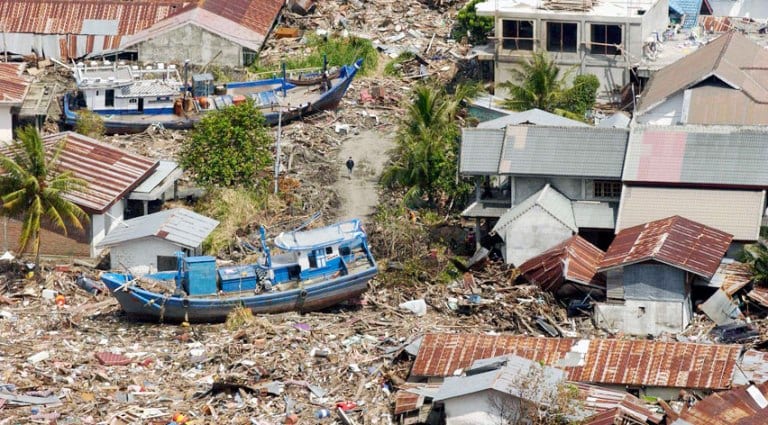The US Military Base at Diego Garcia
The IDA/IRIS seismic station DGAR (Diego Garcia) , is in a vault located on the grounds of the US Air Force’s Ground-Based Electro-Optical Deep Space Surveillance (GEODSS) station at the US military base. (The GEODSS Diego Garcia facility provides “space surveillance data” through three powerful telescopes. GEODSS also monitors moving objects and meteorites; concomitantly, it also uses seismographic data.)
The Seismic Station At Diego Garcia established in Feb 2004 transmits data to IRIS and NEIC
The seismic recording equipment installed in the underground vault. The sensors rest on the central pier, which is directly attached to the coral that underlies the vault so that the instruments can best record the shaking caused as seismic waves travel through the earth.
While DGAR was established with the cooperation of the US military, it is categorized as a civilian scientific facility. The later uses the island’s military base’s communications facilities to transmit its seismic readings to the IDA/IRIS center in Seattle.
Whether the seismographic readings from DGAR were directly available to military personnel on location at Diego Garcia at the GEODSS facility is not known, although the Diego Garcia military authorities would most probably have near real time access to the seismic data monitored by NEIC and other seismic centers, which are hooked up to the Military.
In other words, in all likelihood, the US military had the relevant data on their computer screens within minutes of its transmission.
More generally, there are close interagency links between the relevant civilian and military entities. NOAA, while formally a civilian body under the jurisdiction of the Department of Commerce, is headed by a former Vice Admiral, and NOAA Weather services, which oversees the PTWCs in Hawaii and Alaska is administered by a retired US Air Force Brig. General. (See http://www.nws.noaa.gov/johnson_bio.php )
The Monitoring System of the Comprehensive Nuclear-Test-Ban Treaty (CTBTO)
In addition to the IDA/IRIS stations, the International Monitoring System (IMS) of the Preparatory Commission for the Comprehensive Nuclear-Test-Ban Treaty Organization (CTBTO) based in Vienna, operates several stations in the Indian Ocean region, three of which are in fact located in the Chagos Archipelago (British Indian Ocean Territory). (See map below) Two of these stations are situated directly on the site of the US military base. In other words, there are in all four stations in the Chagos archipelago, which use the communications system of the US military base.
The IMS confirmed that it recorded the December 26th earthquake at 78 of its stations, including those in the Indian Ocean in near real time, “within seconds to minutes of the event.” (of the 78 IMS stations, 71 were using the seismic, six the hydroacoustic and one the infrasound technologies. The latter (infrasound station) was located within proximity of the Diego Garcia military base in the Chagos Archipelago.
The CTBTO confirms in this regard that “the first automatic event list containing the Sumatra earthquake was released by the International Data Center (IDC) in Vienna two hours after the event.” It nonetheless confirms that the “raw data from the monitoring stations” were communicated “in near real time” ( almost immediately) to national data centers of state signatories including Australia, Indonesia and Thailand. (See text of CTBTO Press Release ).
Four Monitoring Stations in the Chagos Archipelago
The first news reports underscored the fact that the US military base at Diego Garcia had been given advanced warning, but that the information reached military officials at the US island naval base “after” the tsunami had hit India and Sri Lanka:
“An NOAA log shows that the US Pacific Command, including Diego Garcia, was given a specific warning about the tsunami some two and three quarter hours after the earthquake” (The Guardian, 7 Jan 2005)
The fact of the matter, as mentioned earlier, is that the data concerning the earthquake originated from monitoring stations situated on the site of the US island military base. In other words, the US military base at Diego Garcia , with its advanced monitoring facilities, research labs, etc. was not the “recipient” but rather “the source” of the relevant data regarding the earthquake. (See Table 1).
It is the source not only of seismic information (not to mention satellite imaging) but of other types of data, used to ascertain the causes of an earthquake, from three other monitoring stations in the Chagos islands, which are linked up to the IMS/ CTBTO :
BIOT/Chagos Radionuclide Station (RN66) at Diego Garcia military base is a radionuclide station which monitors traces of radioactivity in the Indian Ocean basin
BIOT/Chagos Hydroacoustic Station (HA08)(Diego Garcia military base ), which has the ability of “detecting explosions on the ocean surface and under the water”
the BIOT/Chagos Infrasound Station (IS52) (located North of Diego Garcia, see map below) which “provides evidence of a possible atmospheric explosion by detecting sound pressure waves in the atmosphere”.
(see http://pws.ctbto.org/verification/facilities/monfacoutput.dhtml?&vcol=a.name&vord=desc )
The Vienna based IMS also had relevant information, within minutes of the M-9.0 earthquake. To date, none of the data recorded at its Indian Ocean stations has been made public, although it is normally transmitted to the signatory governments and is no doubt also available to the US military.
The functions of these three IMS stations under the CTBTO mandate are as follows:
“The IMS uses seismic, hydroacoustic and infrasound monitoring technologies to detect the transient signals created when the energy is released in underground, underwater and atmosphere environments, respectively. Radionuclide monitoring technologies collect and analyze air samples for evidence of the physical products created and carried by the winds. Seismic, hydroacoustic and infrasound, or the wave technologies, all utilize sensors which record signals from explosions and naturally occurring events in the form of digital waveforms. These digital waveforms or time series provide diagnostic information to detect, locate and characterize the energy source. Radionuclide technology is based on air samplers which collect and analyse atmospheric particulate matter deposited on collection filters. The analysis of the radionuclide content uniquely confirms the fact of a nuclear explosion.”
(For further details see, CBTO, The Global Verification Regime and the International Monitoring System, Vienna, 2001 http://pws.ctbto.org/reference/outreach/booklet3.pdf )
In other words, the data collected by the three Chagos islands IMS stations have the capacity of “registering shock waves emanating from a nuclear explosion underground, in the seas and in the air, as well as detecting radioactive debris released into the atmosphere.”
This data could shed light on the nature of the disaster, while also dispelling speculation by some news media that the tsunami could have been caused by an underground explosion.
It is therefore crucial that the readings from these three BIOT IMS stations, which are available to the signatory governments, be promptly released and analyzed.
Map of Diego Garcia Military Base and Chagos archipelago
http://www.lib.utexas.edu/maps/islands_oceans_poles/diego_garcia_pol80.jpg
In addition to real time seismic data (as well as hydroacoustic, infrasound and radionuclide data), satellite images of the disaster on the North Sumatra coastline were also available in near real time to a number of agencies and international organizations.
The US has an advanced “spy satellite” system, with very precise capabilities of monitoring the terrain, including changes in the natural environment, not to mention moving objects. The National Reconnaissance Office (NRO), which was responsible for launching the first spy satellites of the Cold War era operates a sophisticated system of reconnaissance satellites, which transmit imagery and other data in real time.
The data received by the NRO are relayed to a number of US government/ military bodies including the Department of Defense and the CIA.
As part of its mandate, the NRO has the ability to:
” warn of potential trouble spots around the World, help plan military operations and monitor the environment”
The NRO has close links to the Diego Garcia base from which it operates “The Global Broadcast System”, a special classified broadband communication system. “A GBS satellite parked above the Indian Ocean island of Diego Garcia relayed everything from video feeds of Predator UAVs, to video downlinks for special operations soldiers on horseback in remote regions of western Afghanistan.” ( See http://www.globenet.free-online.co.uk/articles/spacesupremacy.htm )
Another key US body, involved in satellite imagery is the National Geospatial-Intelligence Agency, (NGA) , formerly known as the National Imagery and Mapping Agency. The latter was in fact the architect of the global positioning system (GPS), which was conducive to creating a system of global geospatial intelligence (GEOINT).
NGA is part of the US defense system, it serves the Department of Defense and the intelligence community. It has very precise capabilities of monitoring the geographic and physical terrain by satellite, all over the world, using the techniques of geospatial intelligence (GEOINT).
Geospatial intelligence is described by the NGA as:
“the most valuable tool for envisioning and predicting activity around the World. It serves anyone from the White House to the pilothouse, from the Situation room to the ready room”
In other words, state of the art satellite imagery (available to military, intelligence, civilian as well as private commercial entities) provides “a real time set of eyes”. With regard, to the M-9.0 tsunami of December 26, satellite images were available almost immediately. The US military confirms in this regard, that it has access from its satellite systems “to vital intelligence in real time”. These real time images were used extensively in the Iraq and Afghan war theaters. (Hearings of Sen Armed Services Committee, 25 Feb 2004).
The European Space Agency
Real time seismic and other data (including satellite imagery) were also available to a number of countries including Russia, China, Japan and the European Union.
In this regard, The European Space Agency (ESA ), which has links to NOAA, has “multi-sensor access” in real time to data from satellites including very precise imagery which allows:
“for complete large-scale phenomena to be observed to an accuracy and entirety it would take an army of ground level observers to match”
According to ESA ,
” a single satellite image has the potential to show the spread of air pollution across a continent, the precise damage done to a region by an earthquake or a forest fires, or the entire span of a 500 km, hurricane from the calmness of its eye to its outermost storm fronts. The same space based sensor gathers data from sites across the World, including places too remote or otherwise inaccessible for ground based data acquisition.”
In addition to imagery, the satellite transmits other relevant data which measures very accurately “ground motion” and “sea height”:
“Other sensors known as radar instruments actively shine microwaves pulses down to Earth in order to record how these pulses get reflected back up to space.
These instruments measure surface roughness instead of light or heat energy, and have the advantage of being able to see through cloud and darkness. And by combining together different radar images of the same location – a technique known as interferometry – tiny millimeter-scale ground motion can be identified.
A different type of instrument named an altimeter records very precisely the time it takes for a microwave or laser pulse to be bounced back to the satellite, measuring both land and sea height to an accuracy of a few centimetres.“(http://www.esa.int/export/esaEO/SEMH2Q1VQUD_index_0.html )
The European Space Agency (ESA) is part of a network. It is a member of the International Charter: Space and Major Disasters along with the Centre national d’études spatiales (CNES), the Canadian Space Agency (CSA), the Indian Space Research Organisation (ISRO), the National Oceanic and Atmospheric Administration (NOAA) and Argentina’s Comisión Nacional de Actividades Espaciales (CONAE)
While “before” and “after” images of the disaster have been made public, the images which show the progress and movement of the tsunami, in the period immediately following the earth quake have not been released.
Continued on next page…





